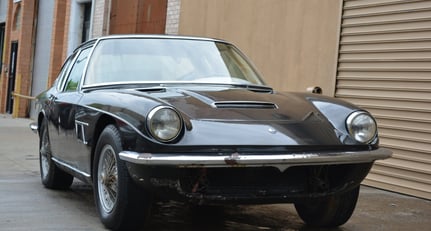1968 Maserati Mistral
4.0-
Baujahr3/1968
-
AutomobiltypCoupé
-
ChassisnummerAM109 A1*1596*
-
Elektrische FensterheberJa
-
LenkungLenkung links
-
ZustandRestaurierungsobjekt
-
Markenfarbe außenVolpe Argentata - Dark Brown
-
InnenfarbeWeiss
-
Markenfarbe innenSenapa - Tan
-
InnenausstattungLeather
-
Anzahl der Türen2
-
Zahl der Sitze2
-
Standort

-
AußenfarbeSchwarz
-
GetriebeManuell
-
Antrieb2wd
-
KraftstoffPetrol
Beschreibung
This Maserati Mistral Coupè 4.0, AM109 A1 *1596*, came to life destined to become a testament to Maserati's legacy of elegance and innovation. This particular car, painted in "Volpe Argentata" (Dark Brown) and adorned with a "Senape Tan" interior, was a masterpiece of design and engineering.
This car's unique identity was further accentuated by its detailed specifications. The order form detailed its "Volpe Argentata 106. E. 44" exterior and "Pelle senape PAC 1375" interior, complemented by dark orange carpets. The car was equipped with a defroster on the rear window, a grab handle on the dashboard, rubber handles above the doors, and a customized steering wheel. The addition of a Maserati Autovox radio with two speakers, an electric antenna, three-tone horns, and seat back pockets. In the Archive documents, a request is noted to have an "excellent engine - silent," highlighting Maserati's commitment to performance and refinement.
AM109 A1 *1596* was ordered on January 15, 1968, and delivered on April 17, 1968, through the dealer Ditta Orfeo Ferasin in Vicenza to the company Hurth Italian s.p.a in the Arco-Trento region of Italy.
The Mistral was introduced at the Torino Salone in November 1963 as a "Berlinetta 2 posti," capturing immediate admiration for its stunning design and Maserati elegance. Pietro Frua, the car's designer, fulfilled his long-held ambition to lead a major Maserati production model with the Mistral, aptly named after a wind that sweeps through France's Rhone river valley.
Mechanically, the Mistral started with a 3.5-litre engine. Still, most models featured a more powerful 3.7-litre capacity, eventually evolving to 4-litre, like this car. This innovation was paired with Lucas fuel injection and a ZF five-speed transmission, ensuring a smooth and responsive driving experience.
The production of the Mistral was an elaborate process involving numerous stages and subcontractors. The chassis, made by Maserati, was sent to Maggiora for body manufacturing and fitting. These shells then went to Officine Padane for pre-assembly, including interiors and electrical circuits, before returning to Maserati for final assembly.
844 Mistrals were built between 1963 and 1969, with AM109 A1 *1596* marking a significant part of this lineage. The Mistral model was retired in 1969 as the last of the inline 6-cylinder model evolution for Maserati.




















































